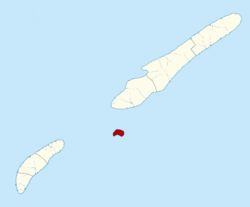Kikik County
Kikik County
Qikiqtakuluk naasarninga (Itchalnu) | |
|---|---|
 | |
| Country | |
| Founded | June 11, 1869 |
| County seat | Lombelon Bay |
| Government | |
| • Commissioner | Edna Banks |
| Area | |
| • Total | 390.21 km2 (150.66 sq mi) |
| Population (2021) | |
| • Total | 268 |
| • Rank | 7th in Surrow |
| • Density | 0.69/km2 (1.8/sq mi) |
| Time zone | UTC-4 (Surrowese Standard Time) |
| • Summer (DST) | not observed |
Kikik County (Itchalnu: Qikiqtakuluk naasarninga) is a county on the Surrowese Kikik Island. Established in 1868 after being carved out of Northland County, Kikik County is the smallest county by both area and population, with an area of only 390.21 square kilometres, and a population of 268 as of the 2021 census.
Etymology
The name Kikik County derives from the Itchalnu word for island, qikiq, with its discoverer, Josias Broughton, naming the island after what the local Itchalnu called them in 1511.
The Itchalnu name for the island and the county is Qikiqtakuluk, which means little island, referring to the island's small size in relation to Great Island and Holcot Island.
History

The first Auressian settlement to be established on Kikik Island was Lombelon Bay, which was established in 1607 by Rythenean fishermen. As the first settlement in Northland County, which was nominally established in 1563 alongside Southland County, Lombelon Bay quickly became its county seat, even though Lombelon Bay would only become a permanent settlement in 1698. This was followed by the establishment of Nirisinoot in 1658 as a seasonal settlement and Whitton Reed in 1721 as a year-round settlement. During the Eleven Years' War, Kikik Island, much like the rest of the Surrowese archipelago was controlled by Tyrnica.
In the aftermath of the Eleven Years' War, both Nirisinoot and Whitton Reed became permanent settlements, although Lombelon Bay remained the largest city on Kikik Island. As part of Northland County, the county government was able to maintain control over the entire island, primarily due to its small size in comparison to neighbouring Great Island, which led to tensions between the settlements on Great Island and those on Kikik Island. This would lead to Kikik County being carved out of Northland County in 1868, with the establishment of a fully-elected county council that year.
In the late nineteenth and early twentieth century, Kikik County's population would peak around 1,200 people, spread across five outports (Lombelon Bay, Whitton Reed, Nirisinoot, Port Glee, and Ickalukaluaktut), although Lombelon Bay had around sixty percent of the county population due to it being the county seat and the major economic centre on the island.
The harsh geography of Kikik Island and its remoteness from the rest of Surrow would lead to a population decline that began from the First Great War onward. As early as the 1940s, questions began to emerge over Kikik County's long-term future, with some in Ted Fisher's government suggesting that Kikik Island become part of the Southern Improvement District. However, as the population in 1941 was still at 608 people, and finances seemed stable, Kikik County was permitted to maintain its county status.
Its continued population decline would lead to President Michael Chambers proposing that Kikik County be merged into a new "Northern Region" as part of his proposed administrative reforms in 1993. This was met with vociferous opposition from most people in Kikik County, leading to Chambers' ouster in 1993 and his replacement by Trevor Morrow.
By the 2010s, Kikik County began to face a financial crisis as its declining population and declining tax revenues, while still being expected to maintain the same responsibilities of a county. This has led to investigations, with Wyatt Martel proposing that Kikik County either be merged with Disappointment County or with Iqittiniq District in 2017. This was opposed by many residents, who wanted Kikik County to maintain its status as a county.
Government
Kikik County is governed by a five member county council (Itchalnu: katimajiit), elected every four years. Since the 2022 redistribution and the June 2022 election, four councilors represent Lombelon Bay, and one councilor represents the rest of Kikik County.
The county council is headed by a commissioner (Itchalnu: kamisina), with the current commissioner being Edna Banks, who was first elected on June 30, 1994. She succeeded Dud Brightman as commissioner, who served in that role from 1970 until his defeat in the 1994 county election.
Per the Surrowese constitution, Kikik County, like all other counties in Surrow, has power over infrastructure maintenance, trial courts, emergency services, land registration, day-to-day operations of schools, and provision of medical services.
Demographics
As of the 2021 census, Kikik County's population was measured at 268 people.
Racially, 259 people, or around 96.6% of the population are of Auressian descent, with estimates suggesting that around 85% of the county population are of Rythenean descent, and 10% of Tyrnican descent. 7 people, or around 2.6% of the county population are of Native Surrowese descent, with estimates suggesting that 100% of the Native Surrowese population are Itchalnu. 2 people, or around 0.8% of the county population belong to other races.
Religiously, 265 people, or around 98.9% of the county population follow Perendism, with 3 people, or around 1.1% of the county population being irreligious.
Linguistically, 261 people, or around 97.4% of the county population speak Rythenean as a first language. 3 people, or around 1.1% of the county population speak Itchalnu as a first language. Finally, 4 people, or around 1.5% of the county population speak other languages as their first language.
Settlements
Kikik County is home to one village (Itchalnu: nunaliralaaq): Lombelon Bay, with a population of 258 people as of the 2021 census.
